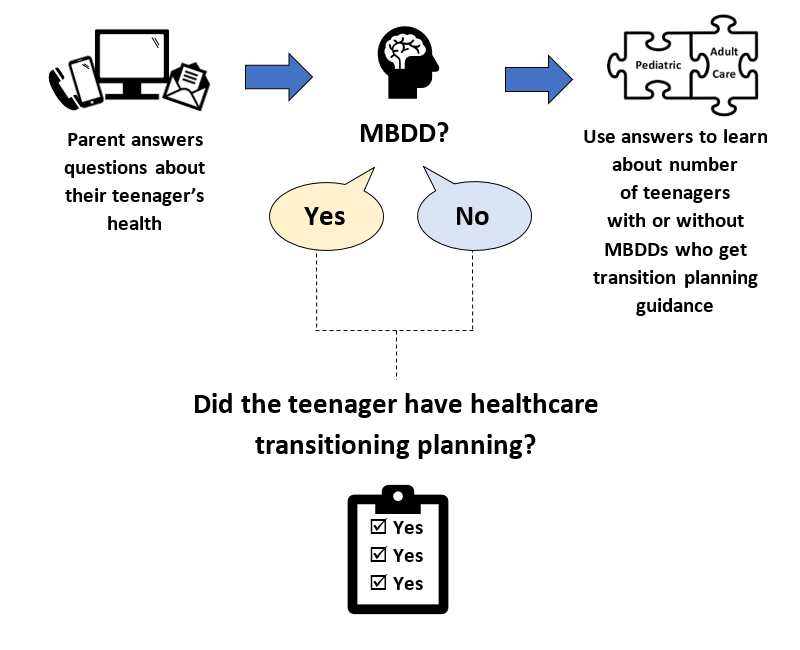Gaps in helping adolescents with mental, behavioral, and developmental disorders transition to adult health care: An Easy-Read Summary
This is an Easy-Read Summary of the following report:
- Leeb RT, Danielson ML, Bitsko RH, Cree RA, et al (2020). Support for transition from adolescent to adult health care among adolescents with and without mental, behavioral, and developmental disorders—United States, 2016–2017. Morbidity and Mortality Weekly Report (MMWR).
1. What was this study about?
Scientists at the Centers for Disease Control and Prevention (CDC) did a study to see if doctors and other people who take care of children’s health (healthcare providers) are helping families of teenagers with mental, behavioral, or developmental disorders (MBDD) prepare to transition, or switch, to an adult healthcare provider.
2. What does support for transition from adolescent to adult health care mean?
At around 18 years old, children will need to transition from a doctor who treats children (pediatrician) to a doctor who treats adults. They will also need to be able to take care of their health needs by themselves, such as scheduling their own doctor appointments. It is important to begin planning for this switch when children are teenagers (adolescents). This helps them be ready when it is time to make this transition.
3. What is the recommended healthcare transition planning?

The American Academy of Pediatrics (AAP) recommends healthcare transition planning for all teenagers, starting when they are 12 years old. Recommended healthcare transition planning is information that healthcare providers give to teenagers to help them stay healthy when it is time for them to switch to a healthcare provider for adults.
The AAP recommends that healthcare providers
- Speak with the teenager separate from family members during office visits;
- Discuss the switch to adult care; and
- Help the teenager take care of their own health care.
4. Where did the information for this Easy-Read Summary come from?
- The information for this study
- Comes from the National Survey of Children’s Health (NSCH), administered in 2016–2017; and
- Includes information from the parents of 29,286 teenagers (aged 12–17 years) with or without MBDD, who were asked about the health and well-being of their teenager.
- The NSCH includes two questions to find out if the teenager has a MBDD:
1. “Has a doctor or other healthcare provider ever told you that your child has (a specific MBDD)?”
and
2. Does the child currently have the MBDD?
If parent answered “yes” to both questions, the teenager has a MBDD.
- NSCH also includes questions to find out if a teenager received help planning their transition to an adult provider.
1. Adolescent talked with their healthcare provider alone during the visit
2. Healthcare provider helped adolescent gain new skills and understand how their health care changes at age 18
3. Healthcare provider discussed changing from pediatric to adult health care
If parent answered “yes” to all three questions, the teenager received healthcare transition planning.

5. What did this study find?
- Most teenagers (aged 12–17 years) did not receive the recommended transition planning to prepare for the move from pediatric to adult health care. Only about 1 in 6 teenagers with MBDDs got the recommended transition planning.
- Among younger teenagers (aged 12–14 years) with MBDDs, 1 in 10 got the recommended transition planning.
- Gaps in planning differed by the type of MBDD that the teenager had:
- Although teenagers with depression and anxiety (fear or worry) were more likely than teenagers without MBDDs to get transition planning, most did not get the recommended planning.
- Teenagers with some developmental disorders, specifically those with autism spectrum disorder (ASD) or developmental delay, were less likely than teenagers without MBDDs to get the recommended transition planning.
- Most teenagers who were getting medication and/or behavioral treatment for MBDDs did not get the recommended transition planning, putting them at risk for stopping treatment.
- Gaps in planning differed by the type of MBDD that the teenager had:
6. Why are these findings important?
- It is important for all teenagers—including teenagers with MBDDs—to get early healthcare transition planning, before they become adults.Early transition planning can help teenagers
- Take an active part in their own care during the move to adult care;
- Continue their current treatment into adult care; and
- Lower their chance of becoming sick.
7. How can more teenagers with MBDDs get transition planning?
Healthcare providers, parents, and communities can work together to help increase the number of teenagers with MBDDs who receive recommended transition planning.
- Healthcare providers can
- Learn about the AAP recommendations and use them when providing care to teenagers starting at age 12 years.
- Join trainings about the unique care needs of teenagers.
- Parents can ask their child’s pediatric healthcare provider about transition planning for their teenager.
- Teenagers can ask their healthcare provider about transition planning for their own health care.
- Communities and schools can consider offering transition programs outside the doctor’s office .
Glossary: What the words mean
Teenagers in this study are children who are 12–17 years old. In this study, young teenagers are those children aged 12–14 years old.
Centers for Disease Control and Prevention (CDC) is a federal public health agency that responds to urgent health concerns in the United States.
Healthcare providers are people such as nurses and doctors who take care of people’s health. Pediatric healthcare provider means someone who takes care of children and adolescents. Adult healthcare provider means someone who takes care of adults. Some healthcare providers take care of children, teenagers, and adults.
Recommended Healthcare Transition Planning is help, support, and tips that healthcare providers give to teenagers to make sure they stay healthy when they move from pediatric (child) to adult health care.
National Survey of Children’s Health (NSCH) is a set of questions completed by parents or guardian about the health and well-being of their teenagers.
Survey is a way to ask a lot of people the same questions.
Note:
It is important to remember that parents responded to the questions in this study based on what they knew about their teenager at one point in time. Parents may not know everything that was said when teenagers and healthcare providers had discussions separate from family members. Not all parents who were asked to take part in the NSCH survey completed the questions.
What is CDC?
The Centers for Disease Control and Prevention (CDC) is a federal public health agency. CDC responds to urgent health concerns. CDC also works to learn about mental, behavioral, and developmental disorders (MBDDs) so that children and teenagers (adolescents), ages 12–17 years, and their families get the support they need.
Development:
This Easy-Read Summary was developed using the Learning More about Health of People with Intellectual and Developmental Disabilities (IDD) as a guide.
Recommended Citation for this Easy-Read Summary:
National Centers on Birth Defects and Developmental Disabilities (2020). Mental Distress Among Adults with disabilities: An Easy-Read Summary. Available at: CDC MMWR WEB PAGE https://www.cdc.gov/mmwr/index2020.html

